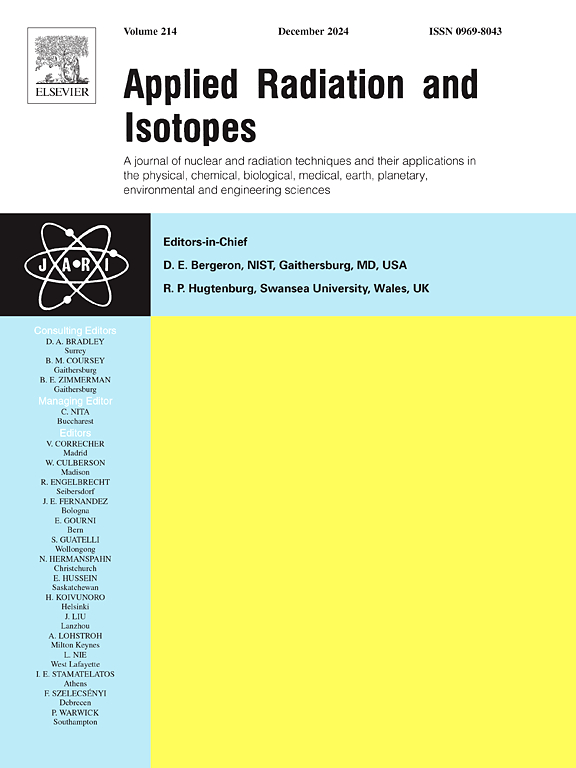Synthesis, structural characterization, and photoluminescence behavior of NaCa4(BO3)3:Tb3+ phosphors Co-doped with K+: Insights into radiation-induced defect formation and charge compensation via DFT calculations
IF 1.8
3区 工程技术
Q3 CHEMISTRY, INORGANIC & NUCLEAR
引用次数: 0
Abstract
This study explores the structural, optical, and electronic properties of NaCa4(BO3)3:Tb3+ phosphors, with and without K+ co-doping, via experimental techniques and Density Functional Theory (DFT). X-ray diffraction confirmed Tb3+ and K+ incorporation without phase change. Optimal green photoluminescence at 542 nm occurred at 2 wt% Tb3+; higher doping led to quenching due to multipolar interactions. While Tb3+ enhanced luminescence, K+ co-doping reduced it, likely from charge imbalance and defect formation. DFT results aligned with experiments, showing minor lattice distortion from Tb3+ and structural instability from K+, reflected in a slight band gap reduction (from 5.00 eV to 4.97 eV). Bader charge and formation energy analyses confirmed K+ does not fully compensate for charge imbalance, contributing to non-radiative centers and reduced luminescence. CIE analysis indicated tunable emission between green and yellow-green. These findings reveal K+ impacts beyond charge compensation, offering insights for phosphor design in solid-state lighting.
K+共掺杂NaCa4(BO3)3:Tb3+荧光粉的合成、结构表征和光致发光行为:通过DFT计算对辐射诱导缺陷形成和电荷补偿的见解
本研究通过实验技术和密度泛函理论(DFT)探讨了有和没有K+共掺杂的NaCa4(BO3)3:Tb3+荧光粉的结构、光学和电子性质。x射线衍射证实Tb3+和K+掺杂,无相变。当Tb3+浓度为2 wt%时,在542 nm处产生最佳的绿色光致发光;高掺杂导致多极相互作用导致猝灭。虽然Tb3+增强了发光,但K+共掺杂降低了发光,可能是由于电荷不平衡和缺陷的形成。DFT结果与实验结果一致,显示Tb3+引起的轻微晶格畸变和K+引起的结构不稳定,反映在带隙减小(从5.00 eV降至4.97 eV)。Bader电荷和形成能分析证实,K+不能完全补偿电荷不平衡,导致非辐射中心和发光降低。CIE分析表明在绿色和黄绿色之间可调的发射。这些发现揭示了K+在电荷补偿之外的影响,为固态照明中的荧光粉设计提供了见解。
本文章由计算机程序翻译,如有差异,请以英文原文为准。
求助全文
约1分钟内获得全文
求助全文
来源期刊

Applied Radiation and Isotopes
工程技术-核科学技术
CiteScore
3.00
自引率
12.50%
发文量
406
审稿时长
13.5 months
期刊介绍:
Applied Radiation and Isotopes provides a high quality medium for the publication of substantial, original and scientific and technological papers on the development and peaceful application of nuclear, radiation and radionuclide techniques in chemistry, physics, biochemistry, biology, medicine, security, engineering and in the earth, planetary and environmental sciences, all including dosimetry. Nuclear techniques are defined in the broadest sense and both experimental and theoretical papers are welcome. They include the development and use of α- and β-particles, X-rays and γ-rays, neutrons and other nuclear particles and radiations from all sources, including radionuclides, synchrotron sources, cyclotrons and reactors and from the natural environment.
The journal aims to publish papers with significance to an international audience, containing substantial novelty and scientific impact. The Editors reserve the rights to reject, with or without external review, papers that do not meet these criteria.
Papers dealing with radiation processing, i.e., where radiation is used to bring about a biological, chemical or physical change in a material, should be directed to our sister journal Radiation Physics and Chemistry.
 求助内容:
求助内容: 应助结果提醒方式:
应助结果提醒方式:


